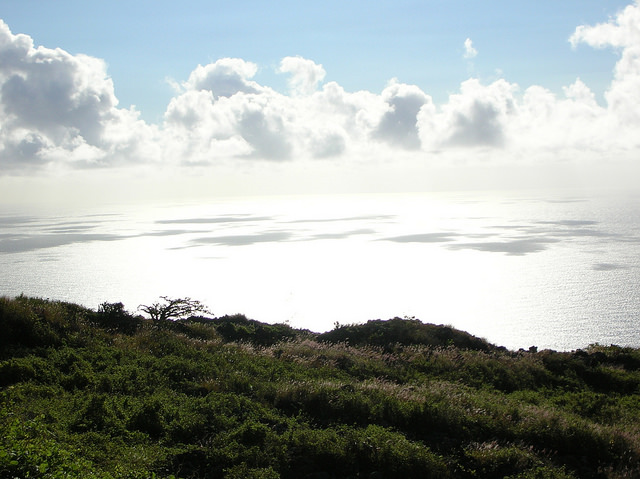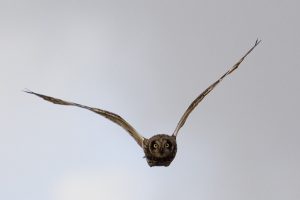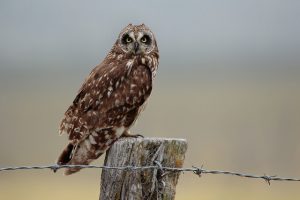
KAHIKINUI PRAYER
Kahikinui is a land district that is approximately 22,860 acres between Kipahulu and Kaupo on the southeastern side of the island. It is bound to the north by Haleakala National Park, to the west by Ulupalakua Ranch and to the east by Haleakala Ranch. The Pacific Ocean laps along its southern boundary.
This YouTube video, “Kahikinui,” was published by Jeremy Johnson using his drone and gives a taste of the sheer expansiveness of the place. (The music is “E Nihi Ka Hele” by the legendary Hawaiian musician Gabby Pahinui)
THE MANY-STORIED LAND
Kahikinui can be a harsh place, a dry and rocky place full of thorns, feral goats and axis deer, and it is, to my mind, one of the most beautiful of Maui’s treasures. The land is mostly undeveloped because of the shortage of water there. Some see it as a good place to put up huge windmills for energy.
Kahikinui is the back of beyond…a hinterland that was inhabited since the early fifteenth century by na kua’aina, the country people. Later planters transformed it into what was called the “greatest continuous zone of dryland planting in the Hawaiian islands.”
It sits mostly empty of people now, but at one time there was a fairly large population. Ruins of old houses, trails, small farms, and a complex system of temples and shrines are scattered throughout the area.

Kahikinui was the subject of a 17-year-long study by anthropologist Patrick Vinton Kirch and his students. He wrote a book about it, KUAAINA KAHIKO, Life and Land in Ancient Kahikinui, Maui. It is an amazing book.
One reviewer calls Kirch “an academic archaeologist who tried to be pono at a time when to be an archaeologist in some circles was to be a social pariah.” Interwoven throughout the book are stories about his relationships with a dedicated group of passionate homesteaders, Ka ‘Ohana o Kahikinui, who were allowed by the Hawaiian Home Lands Commission to set up for a bare-bones homesteading effort.
The Hawaiian Home Lands Commission is a State agency that oversees the distribution of (usually third-rate) farming land to Native Hawaiians, as mandated by the Federal government. That’s a whole, other, very long story fraught with controversy and politics.
The members of the Kahikinui ‘Ohana were willing to do what they had to do to bypass the long, long wait for the government resources to become available to develop the infrastructure that is officially deemed necessary for the people to move back onto the land.

LAND CONNECTION
My husband Fred and I were interested in becoming homesteaders there. Two years after Fred died, the land became available. I was offered a chance to acquire a lease for land there, a posthumous award to my husband.
I had to refuse the offer. By myself, I did not feel able to do it. In gratitude, however, I made a prayer/poem for the homesteaders there.
When I gave it to him, this poem made Mo Moler, the charismatic leader of the group, cry. I was very proud of that. Mo is one tough guy, a Vietnam veteran and a wild man. It is not often that he lets himself cry.

PULE KAHIKINUI
E Akua, hear me.
This is your child who calls you.
Our thanks to you for this land:
For the great bowl of sky and the beauty around us,
For the cool of the mountain, the abundance of sea,
Our thanks.
We come together now to talk about this land,
This land that needs us as we need this land,
So the land may live,
So we may live.
Help us guard our mouths.
Let our words bring light, not darkness.
Help us clear our na’au and hold to our purpose,
So we can resolve our problems
In peace,
With love.
Let us put our minds together and pool our mana’o
And see what we will make together for our keiki.
Help us hold this land as witness to the beauty that was,
To the beauty that is,
To the beauty that can be.
Let us make from this land more beauty,
And with that beauty we will feed our souls.
Help us remember that we are the bridge between
Those who come before us
And those who come after us.
Let us be strong and true to that memory.
Help us remember who we are,
That we are yours as you are ours
And we are all together.
E Akua, hear me.
This is your child who speaks.
To you we offer the glory of this work we do.
It is yours, all yours.
Let the work be pono.
Let the land be pono.
Let us be pono.
E Akua, be with us.
We who are yours,
We ask.
by Netta Kanoho
E Akua is a calling out to the Creative and to the ancestors. Na’au literally means “guts” – a person’s center, where all of the emotions and subconscious thoughts and feelings are held – and where Hawaiians feel the human “mind” is really situated. Mana’o is “knowledge.” Keiki is “children.” Pono means being balanced and being righteous.]
Picture credit: Kahikinui by Forest and Kim Starr via Flickr [CC BY 2.0]
……
SOME OTHER POSTS TO EXPLORE
(Click on each of the post titles below and see where it takes you…)
……
Thanks for your visit. I’d appreciate it if you’d drop a comment or note below.
12 thoughts on “KAHIKINUI PRAYER”
I do belive that blogs like this will be a very important part of the future our future generations will live in. I would have loved to see a drone video of some of the ruins with some explanation of the history tied to them. I become very curious about the area and this natures pearl you are attached to.
Hey Hans:
Kahikinui is, indeed, a very special place. But, then, I think the same about just about every other part of Hawaii. Every bit of the land in the islands has some kind of story, and any story about the island’s peoples is one about the land as well. Don’t know if it’s a cultural thing or what it is. (We even sing love-songs to our winds and rains, to our mountains and valleys….)
Jeremy did a great job with his drone video. Most of the archaeological sites are off-limits to the public right now or very hard to get to. When I knew Patrick (the author of the book), he was a reclusive guy, more wild-thing than civilized scholar. He’d been living on the land and studying it for many years by that time.
Thanks for your visit and your comments. Please do come again….
Thanks for sharing the poem, I remember I saw this saying somewhere, ‘Technology, Science and Engineering is what moved us forward, however love, literature and art is what keep us alive’. We need to spread awareness of art and beauty, the essence of our soul and i think this Kahikinui Prayer is beautiful.
We are moving into a society whereby its filled with greed and the younger generation are not appreciating enough. Thanks for sharing the background of Kahikinui and this poem and thanks for keeping the very essence of humanity alive.
I love that saying, Leo. Thank you for sharing it. Thanks, too, for your visit. Please do come again….
Hello Netta,
Learning about new places have to be one of the best feelings ever and I have always been someone who loves to explore. I have visited a couple of places around the Mediterranean and it’s all been good.
Seeing this article about Kahikinui is fun and engaging and I would be willing to learn more about the weather and lifestyle there before visiting.
ReeceMicheal, thanks for your visit and for sharing your thoughts. I’m glad you enjoyed the post.
Kahikinui has left me wondering about several things. By far, it is a very interesting place because there is a mixture of interesting ingredients.
I would like to become a homesteader. And your post has encouraged me more. It really touched me to hear about your husband’s wish at the end of this post.
Thanks for your visit and for sharing your thoughts, Paolo. I’m so glad the post resonated with you.
Please do come again.
Thanks for sharing this article. I have neever heard of this before but it has been interesting to read and watch the video.
The music in the video also sounds cool. I’m guessing that this is local music? It sounds like it has a cajun touch to it. Was this a French colony at any point per chance?
Kwidzin, thanks for your visit. I’m glad the post was interesting for you.
The music is old-style paniolo (cowboy) music — slack key guitar tunings and pickings with steel guitar flourishes. It suits that country area; feels like you’re riding a horse through the brush and wide-open spaces.
There are all kinds of different stylings of Hawaiian music. Some folks hear echoes of bluegrass in it and others hear Spanish stylings. Other forms take rhythms from reggae, hip-hop, jazz, swing, or rock and roll. We love it all, us Hawaiians.
Please do come by again.
Kahikinui is a very mystical place where few have experienced its incredible beauty. The wonder of the land is so remarkable and so I can sense the great pride and the privilege it would be to live in such a deep place of attachment.
Your poem is very special and inspiring because it touches the heart and deeply embodies your love and bond to this sacred place.
Thanks for the visit and for sharing your thoughts, Toplink. I do appreciate it.
Please do come again.